Bombay Hills
The Bombay Hills are a range of hills to the south of Auckland, New Zealand. Though only a small and seemingly insignificant range of hills, they lie at the southern boundary of the Auckland region, and serve as a divide between Auckland and the Waikato region.[1] There is a 19th-century settlement, Bombay, on the old main road south of Auckland, the Great South Road.

Aucklanders and other New Zealanders have a mostly light-hearted "love-hate" relationship. Stereotypically, Aucklanders view parts of the country "south of the Bombay Hills" as provincial and unsophisticated, while the rest of the country sees Aucklanders as brash and arrogant. For this reason, the boundary between Auckland and its southern neighbours bears great significance. People on both sides of the boundary are as likely to use the phrase "New Zealand stops at the Bombay Hills".[2] The term was adopted by 1990s New Zealand reggae band Southside of Bombay.
Location
The hills are located 40 kilometres (25 mi) southeast of Auckland, close to the town of Pukekohe. State Highway 1 here reaches its highest point between Auckland and Tīrau in the eastern Waikato Region, 134 kilometres (83 mi) to the southeast. Bombay is the nearest settlement to the southern fringe of the Auckland metropolitan area.
Name
The settlement of Bombay and hence the Bombay Hills are directly named after the ship Bombay, which landed in Auckland and brought settlers to the area, originally called Williamson's Clearing, in 1863.[3] The ship itself was named after the Indian city of Bombay (now Mumbai).
Geology
While they may appear to be just a spur of the Hunua Ranges, the Bombay Hills are geologically quite distinct, being mainly of volcanic origin. The hills are overlain by Hamilton Ash tephra which has weathered to create some of the best soils for market gardening in New Zealand.
The Bombay Hills are the barrier that halts the northward progression of the Waikato River. The hills cause it to turn west towards the coast where it empties into the Tasman Sea near Port Waikato
Demographics
| Year | Pop. | ±% p.a. |
|---|---|---|
| 2006 | 1,659 | — |
| 2013 | 1,620 | −0.34% |
| 2018 | 1,974 | +4.03% |
| Source: [4] | ||
Bombay Hills had a population of 1,974 at the 2018 New Zealand census, an increase of 354 people (21.9%) since the 2013 census, and an increase of 315 people (19.0%) since the 2006 census. There were 669 households. There were 972 males and 1,002 females, giving a sex ratio of 0.97 males per female. The median age was 45 years, with 387 people (19.6%) aged under 15 years, 297 (15.0%) aged 15 to 29, 975 (49.4%) aged 30 to 64, and 315 (16.0%) aged 65 or older.
Ethnicities were 85.7% European/Pākehā, 10.3% Māori, 4.0% Pacific peoples, 8.8% Asian, and 2.6% other ethnicities (totals add to more than 100% since people could identify with multiple ethnicities).
The proportion of people born overseas was 19.8%, compared with 27.1% nationally.
Although some people objected to giving their religion, 51.4% had no religion, 35.6% were Christian, 1.8% were Hindu, 1.5% were Muslim, 0.8% were Buddhist and 2.3% had other religions.
Of those at least 15 years old, 306 (19.3%) people had a bachelor or higher degree, and 243 (15.3%) people had no formal qualifications. The median income was $44,200. The employment status of those at least 15 was that 885 (55.8%) people were employed full-time, 261 (16.4%) were part-time, and 42 (2.6%) were unemployed.[4]
Education
Bombay School is a coeducational full primary school (years 1–8) with a roll of 327 as of March 2020.[5][6] The school opened in 1872.[7]
Residents
The Bombay Hills has many former athletes as residents including Eric Murray (Olympic rower), Katherine Prumm (World Champion motorcyclist) and Andy Dalton (former All Black captain). Bombay is also the location of a monastery of enclosed Benedictine nuns, Tyburn Monastery.
Notable buildings
- St Peter in the Forest Church (Anglican)[8]
See also
- The Watford Gap, a similar cultural border concept in the United Kingdom
- Jafa, a sometimes pejorative term for a resident of Auckland
References
- "Auckland's Bombay hills, the frontier". Michaelfield.org. 9 July 2006. Archived from the original on 24 March 2010.
- "Auckland places – Papakura and the rural south-east". Te Ara: The Encyclopedia of New Zealand. Teara.govt.nz.
- "Bombay Hills in the 1966". Encyclopaedia of New Zealand. A. H. McLintock. Retrieved 15 March 2020.
- "Statistical area 1 dataset for 2018 Census". Statistics New Zealand. March 2020. Bombay Hills (166300). 2018 Census place summary: Bombay Hills
- "New Zealand Schools Directory". New Zealand Ministry of Education. Retrieved 26 April 2020.
- Education Counts: Bombay School
- "Opening of Bombay School". Bombay School. Retrieved 27 September 2020.
- "Church of St Peter in the Forest (Anglican)". Register of Historic Places. Heritage New Zealand. Retrieved 27 January 2021.
